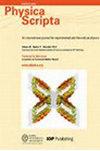Novel method for inversion of microphysical properties of clouds using Raman lidar data
IF 2.6
3区 物理与天体物理
Q2 PHYSICS, MULTIDISCIPLINARY
引用次数: 0
Abstract
Aerosol–cloud–precipitation interactions are important in the balance of Earth’s radiation budget. To further explore the relationship between clouds and precipitation, and to improve operational weather modification, it is necessary to study the microphysical parameters of liquid water clouds. Here, an inversion method that uses a back propagation (BP) neural network based on a genetic algorithm (GA), namely a GABP, is proposed to invert cloud microphysical parameters using ground-based dual-field-of-view (FOV) Raman lidar data. To verify the feasibility of the method, long-term continuous observations were conducted in the Liupan Mountains (China). Results revealed that the proposed inversion method using the GABP is feasible for retrieving the liquid water content (LWC) and the cloud droplet effective radius after training a large number of data measured simultaneously by the Raman lidar and a microwave radiometer. When inverting LWC, the root mean square error (RMSE) of the GABP algorithm was found in the range 0–0.005, whereas the RMSE of the BP algorithm fluctuated in the range 0–0.01. It was evident that the GABP algorithm yields better inversion results and finer detail. When maintaining other variables and comparing the inversion results of signals in the inner and outer FOVs, the RMSE of the inner FOV signal was within 0.005 at near-ground heights (i.e., <2 km), whereas the outer FOV signal exceeded 0.005 at certain heights. This study developed a feasible solution for detecting characteristic cloud microphysical parameters using a Raman lidar, which could be used to study aerosol–cloud–precipitation interactions, and thereby have considerable practical importance for improving artificial rainfall operations.利用拉曼激光雷达数据反演云的微物理特性的新方法
气溶胶-云-降水之间的相互作用对地球辐射预算的平衡非常重要。为了进一步探索云与降水之间的关系,改进业务天气改造,有必要研究液态水云的微物理参数。本文提出了一种基于遗传算法(GA)的反向传播(BP)神经网络反演方法,即 GABP,利用地基双视场(FOV)拉曼激光雷达数据反演云的微物理参数。为了验证该方法的可行性,在中国六盘山进行了长期连续观测。结果表明,在训练了大量拉曼激光雷达和微波辐射计同时测量的数据后,利用 GABP 提出的反演方法在检索液态水含量(LWC)和云滴有效半径方面是可行的。在反演 LWC 时,GABP 算法的均方根误差(RMSE)在 0-0.005 之间,而 BP 算法的均方根误差在 0-0.01 之间波动。显然,GABP 算法的反演结果更好,细节更精细。在保持其他变量不变的情况下,比较内外FOV信号的反演结果,内FOV信号在近地高度(即小于2千米)的均方根误差在0.005以内,而外FOV信号在某些高度超过了0.005。这项研究为利用拉曼激光雷达探测特征云微物理参数提供了可行的解决方案,可用于研究气溶胶-云-降水之间的相互作用,从而对改进人工降雨作业具有重要的实际意义。
本文章由计算机程序翻译,如有差异,请以英文原文为准。
求助全文
约1分钟内获得全文
求助全文
来源期刊

Physica Scripta
物理-物理:综合
CiteScore
3.70
自引率
3.40%
发文量
782
审稿时长
4.5 months
期刊介绍:
Physica Scripta is an international journal for original research in any branch of experimental and theoretical physics. Articles will be considered in any of the following topics, and interdisciplinary topics involving physics are also welcomed:
-Atomic, molecular and optical physics-
Plasma physics-
Condensed matter physics-
Mathematical physics-
Astrophysics-
High energy physics-
Nuclear physics-
Nonlinear physics.
The journal aims to increase the visibility and accessibility of research to the wider physical sciences community. Articles on topics of broad interest are encouraged and submissions in more specialist fields should endeavour to include reference to the wider context of their research in the introduction.
 求助内容:
求助内容: 应助结果提醒方式:
应助结果提醒方式:


